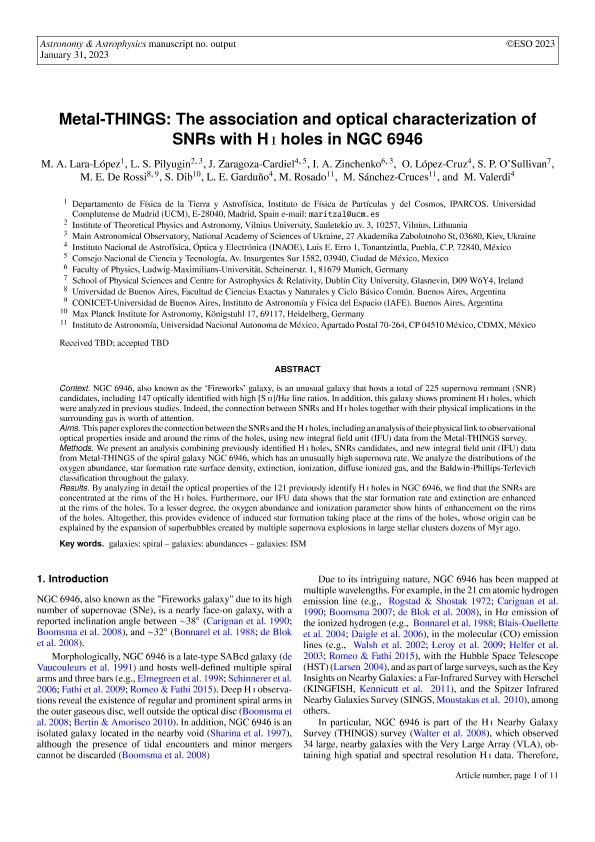Mostrar el registro sencillo del ítem
dc.contributor.author
Lara López, M. A.
dc.contributor.author
Pilyugin, L. S.
dc.contributor.author
Zaragoza Cardiel, J.
dc.contributor.author
Zinchenko, I.A.
dc.contributor.author
López Cruz, Omar

dc.contributor.author
O'sullivan, S. P.
dc.contributor.author
de Rossi, Maria Emilia

dc.contributor.author
Dib, S.
dc.contributor.author
Garduño, L. E.
dc.contributor.author
Rosado, M.
dc.contributor.author
Sánchez Cruces, M.
dc.contributor.author
Valerdi, M.
dc.date.available
2023-12-04T18:13:18Z
dc.date.issued
2023-01
dc.identifier.citation
Lara López, M. A.; Pilyugin, L. S.; Zaragoza Cardiel, J.; Zinchenko, I.A.; López Cruz, Omar; et al.; Metal-THINGS: Association and optical characterization of supernova remnants with H I holes in NGC 6946; EDP Sciences; Astronomy and Astrophysics; 669; A25; 1-2023; 1-11
dc.identifier.issn
0004-6361
dc.identifier.uri
http://hdl.handle.net/11336/219272
dc.description.abstract
Context. NGC 6946, also known as the-Fireworks Galaxy, is an unusual galaxy that hosts a total of 225 supernova remnant (SNR) candidates, including 147 optically identified with high [SII]/Hα line ratios. In addition, this galaxy shows prominent HI holes, which have been analyzed in previous studies. Indeed, the connection between SNRs and HI holes along with their physical implications in the surrounding gas are worthy of attention. Aims. This paper explores the connection between the SNRs and the HI holes, including an analysis of their physical link to observational optical properties inside and around the rims of the holes, using new integral field unit (IFU) data from the Metal-THINGS survey. Methods. We present an analysis combining previously identified HI holes, SNR candidates, and new integral field unit (IFU) data from Metal-THINGS of the spiral galaxy NGC 6946. We analyzed the distributions of the oxygen abundance, star formation rate surface density, extinction, ionization, and diffuse ionized gas, as well as the Baldwin-Phillips-Terlevich classification throughout the galaxy. Results. By analyzing the optical properties of the 121 previously identify HI holes in NGC 6946 in detail, we find that the SNRs are concentrated at the rims of the HI holes. Furthermore, our IFU data show that the star formation rate and extinction are enhanced at the rims of the holes. To a lesser degree, the oxygen abundance and ionization parameter show hints of enhancement on the rims of the holes. Altogether, this provides evidence of induced star formation taking place at the rims of the holes, whose origin can be explained by the expansion of superbubbles created by multiple supernova explosions in large stellar clusters dozens of Myr ago.
dc.format
application/pdf
dc.language.iso
eng
dc.publisher
EDP Sciences

dc.rights
info:eu-repo/semantics/openAccess
dc.rights.uri
https://creativecommons.org/licenses/by-nc-sa/2.5/ar/
dc.subject
GALAXIES: ABUNDANCES
dc.subject
GALAXIES: ISM
dc.subject
GALAXIES: SPIRAL
dc.subject.classification
Astronomía

dc.subject.classification
Ciencias Físicas

dc.subject.classification
CIENCIAS NATURALES Y EXACTAS

dc.title
Metal-THINGS: Association and optical characterization of supernova remnants with H I holes in NGC 6946
dc.type
info:eu-repo/semantics/article
dc.type
info:ar-repo/semantics/artículo
dc.type
info:eu-repo/semantics/publishedVersion
dc.date.updated
2023-11-29T13:21:28Z
dc.journal.volume
669
dc.journal.number
A25
dc.journal.pagination
1-11
dc.journal.pais
Francia

dc.description.fil
Fil: Lara López, M. A.. Universidad Complutense de Madrid; España
dc.description.fil
Fil: Pilyugin, L. S.. National Academy of Sciences of Ukraine; Ucrania. Vilnius University; Lituania
dc.description.fil
Fil: Zaragoza Cardiel, J.. Instituto Nacional de Astrofisica Optica y Electronica; México. Consejo Nacional de Ciencia y Tecnología; México
dc.description.fil
Fil: Zinchenko, I.A.. Ludwig Maximilians Universitat; Alemania. National Academy of Sciences of Ukraine; Ucrania
dc.description.fil
Fil: López Cruz, Omar. Instituto Nacional de Astrofisica Optica y Electronica; México
dc.description.fil
Fil: O'sullivan, S. P.. Dublin City University; Irlanda
dc.description.fil
Fil: de Rossi, Maria Emilia. Universidad de Buenos Aires; Argentina. Consejo Nacional de Investigaciónes Científicas y Técnicas. Oficina de Coordinación Administrativa Ciudad Universitaria. Instituto de Astronomía y Física del Espacio. - Universidad de Buenos Aires. Facultad de Ciencias Exactas y Naturales. Instituto de Astronomía y Física del Espacio; Argentina
dc.description.fil
Fil: Dib, S.. Max Planck Institute For Astronomy; Alemania
dc.description.fil
Fil: Garduño, L. E.. Instituto Nacional de Astrofisica Optica y Electronica; México
dc.description.fil
Fil: Rosado, M.. Universidad Nacional Autónoma de México; México
dc.description.fil
Fil: Sánchez Cruces, M.. Universidad Nacional Autónoma de México; México
dc.description.fil
Fil: Valerdi, M.. Instituto Nacional de Astrofísica, Óptica y Electrónica; México
dc.journal.title
Astronomy and Astrophysics

dc.relation.alternativeid
info:eu-repo/semantics/altIdentifier/doi/http://dx.doi.org/10.1051/0004-6361/202245068
dc.relation.alternativeid
info:eu-repo/semantics/altIdentifier/url/https://www.aanda.org/articles/aa/full_html/2023/01/aa45068-22/aa45068-22.html
Archivos asociados
